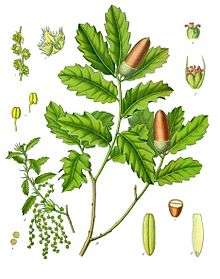Quercus lusitanica
Quercus lusitanica, commonly known as gall oak, Lusitanian oak, or dyer's oak, is a species of oak native to Portugal, Spain (Galicia and western Andalucia) and Morocco.[2] Quercus lusitanica is the source of commercial nutgalls. These galls are produced by the infection from the insect Cynips gallae tinctoriae. They are used for dyeing.
| Gall oak | |
|---|---|
 | |
| 1897 illustration from Franz Eugen Köhler, Köhler's Medizinal-Pflanzen | |
| Scientific classification | |
| Kingdom: | Plantae |
| Clade: | Tracheophytes |
| Clade: | Angiosperms |
| Clade: | Eudicots |
| Clade: | Rosids |
| Order: | Fagales |
| Family: | Fagaceae |
| Genus: | Quercus |
| Subgenus: | Quercus subg. Quercus |
| Section: | Quercus sect. Quercus |
| Species: | Q. lusitanica |
| Binomial name | |
| Quercus lusitanica | |
| Synonyms[1] | |
|
List
| |
Several other species are known colloquially as "gall oaks;" indeed, galls can be found on a large percentage of oak species.[3] The specific epithet "lusitanica" refers to the ancient Roman Province of Lusitania, corresponding roughly to present-day Portugal and Extremadura in Spain.[4]
References
- "Quercus lusitanica Lam.". World Checklist of Selected Plant Families (WCSP). Royal Botanic Gardens, Kew – via The Plant List.
- "Quercus lusitanica". World Checklist of Selected Plant Families (WCSP). Royal Botanic Gardens, Kew.
- Cranshaw, Whitney (2004). Garden Insects of North America. Princeton, New Jersey: Princeton University Press. ISBN 0-691-09560-4.
- Garcia, José Manuel (1989). História de Portugal: Uma Visão Global. Lisboa: Editorial Presença. pp. 32, 33, 38. ISBN 9722309897.
This article is issued from Wikipedia. The text is licensed under Creative Commons - Attribution - Sharealike. Additional terms may apply for the media files.